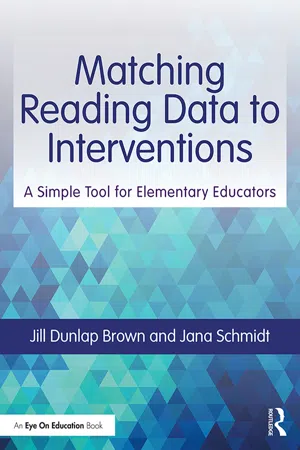![]()
1
An Overview of The Columns
“I have all of this great data about my students, but I’m not sure what to do next!” It’s a sentence we have heard over and over again as we have worked in schools for the past 20 years. Teachers spend time screening students and collecting data, but the power of data comes at the next stage – the stage of identifying the foundational reading need and then matching students to an intervention that will help them become successful readers. This is the link between what we know to do (the research) and the actual work in school. Many call this the “Knowing–Doing Gap” (Sparks, 2007, pp. 179‒184). We know what we should do, but how do we actually do it? The implementation behind the work is difficult. We have spent many hours in data teams with teachers who are eager to do more and understand more so that they can help their students. Because of this need, we developed an assessment analysis tool that we call “The Columns.” The Columns provide teachers with a tool that assists in identifying the foundational reading needs of students in their classrooms. This tool is meant to help teachers understand what foundational reading skill is missing so that the student is placed in the proper reading intervention. We base The Columns on the five components of reading. We know that for a child to be a successful reader, they must be proficient in phonological awareness, phonics, fluency, vocabulary, and comprehension. For teachers to best meet the needs of students, they must be able to identify which components are strong and which are weak, thus allowing them to know the next steps that are required for each child.
The Columns guide the teacher’s thinking as they dissect collected data. The one thing we have learned over the years is that the process must be kept simple. The one thing no teacher has more of is time. Between teaching all the subjects, knowing all the standards, tending to needs of children, recess duty, lunch duty, calls to parents, and many meetings, teachers need a process that is quick, efficient, and gives them exactly the information essential to ensuring the foundational reading needs of their students are met. We worked for many years to create just this – a process that is easy to understand and a guide that is easy to implement. In this chapter, we will share The Columns and provide an overview of what teachers will find when using The Columns for foundational reading data analysis, as well as how The Columns can be helpful for administrators. In the subsequent chapters, teachers will be given the tools to understand how The Columns work for kindergarten, first grade, and grades 2 through 5. We will explain the nuances of each, and the decisions that a teacher makes as deficient skills in foundational reading are realized. To see what The Columns look like, please turn to page 4.
What Are The Columns?
The Columns were developed to provide an efficient data analysis tool to help identify the foundational reading skill that might be missing, and then match that deficient skill to an intervention. They are set up in a simple format that allows the teacher to read the data decision rules in each Column. Then the tool helps to guide the teacher to determine what foundational reading skill might be missing, and finally, references the intervention that matches the deficit. While in this book we discuss both universal screening assessment tools and interventions that might be used, the power of The Columns is that they are adaptable to data tools and interventions that your school might use. We know that there are many choices for reading screeners and interventions. It is not our intention to promote one tool or program over another, but rather to help schools to best use the tools they have selected and identify which intervention matches the foundational reading skill deficit that is found in the data collected. Often times, schools have many interventions available, but may not know how to match the intervention to the need. Our tool will help you decide how to place interventions you currently use into The Columns to ensure students are matched to the correct intervention. Further, it will help you identify where you might need additional interventions for students. The tools and interventions we mention in this book are those we have used in schools over the years. We know there are many choices for schools. We hope this tool helps you align what you have and also identifies what might still be needed. Gaps in foundational reading knowledge will surface when collecting student data.
The Columns are available for each grade level, K-5. We devote one chapter to just kindergarten and one to first grade, to be able to address the beginning phases of reading. For kindergarten, there are five Columns for analysis. Grade 1 has six Columns for the first semester, and then it is reduced to four Columns for the second semester. Grades 2–5 have four Columns focused on expanding the knowledge of those learners. In total, a school will have four sets of Columns for grades K-5.
Each Column begins by using the data from a universal screener. At the beginning of each school year, teachers give a universal screening assessment to all students in their classroom. This is typically done for all students again in mid-year, and again at the end of the year. Over time, growth is measured for students. Your school mi...
